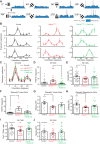Ube3a loss increases excitability and blunts orientation tuning in the visual cortex of Angelman syndrome model mice
- PMID: 28468997
- PMCID: PMC5511875
- DOI: 10.1152/jn.00618.2016
Ube3a loss increases excitability and blunts orientation tuning in the visual cortex of Angelman syndrome model mice
Abstract
Angelman syndrome (AS) is a neurodevelopmental disorder caused by loss of the maternally inherited allele of UBE3AUbe3aSTOP/p+ mice recapitulate major features of AS in humans and allow conditional reinstatement of maternal Ube3a with the expression of Cre recombinase. We have recently shown that AS model mice exhibit reduced inhibitory drive onto layer (L)2/3 pyramidal neurons of visual cortex, which contributes to a synaptic excitatory/inhibitory imbalance. However, it remains unclear how this loss of inhibitory drive affects neural circuits in vivo. Here we examined visual cortical response properties in individual neurons to explore the consequences of Ube3a loss on intact cortical circuits and processing. Using in vivo patch-clamp electrophysiology, we measured the visually evoked responses to square-wave drifting gratings in L2/3 regular-spiking (RS) neurons in control mice, Ube3a-deficient mice, and mice in which Ube3a was conditionally reinstated in GABAergic neurons. We found that Ube3a-deficient mice exhibited enhanced pyramidal neuron excitability in vivo as well as weaker orientation tuning. These observations are the first to show alterations in cortical computation in an AS model, and they suggest a basis for cortical dysfunction in AS.NEW & NOTEWORTHY Angelman syndrome (AS) is a severe neurodevelopmental disorder caused by the loss of the gene UBE3A Using electrophysiological recording in vivo, we describe visual cortical dysfunctions in a mouse model of AS. Aberrant cellular properties in AS model mice could be improved by reinstating Ube3a in inhibitory neurons. These findings suggest that inhibitory neurons play a substantial role in the pathogenesis of AS.
Keywords: Angelman syndrome; Ube3a; autism; visual cortex.
Copyright © 2017 the American Physiological Society.
Figures







Similar articles
-
Maternal Loss of Ube3a Impairs Experience-Driven Dendritic Spine Maintenance in the Developing Visual Cortex.J Neurosci. 2016 Apr 27;36(17):4888-94. doi: 10.1523/JNEUROSCI.4204-15.2016. J Neurosci. 2016. PMID: 27122043 Free PMC article.
-
Adult Ube3a Gene Reinstatement Restores the Electrophysiological Deficits of Prefrontal Cortex Layer 5 Neurons in a Mouse Model of Angelman Syndrome.J Neurosci. 2018 Sep 12;38(37):8011-8030. doi: 10.1523/JNEUROSCI.0083-18.2018. Epub 2018 Aug 6. J Neurosci. 2018. PMID: 30082419 Free PMC article.
-
Maternal loss of Ube3a produces an excitatory/inhibitory imbalance through neuron type-specific synaptic defects.Neuron. 2012 Jun 7;74(5):793-800. doi: 10.1016/j.neuron.2012.03.036. Neuron. 2012. PMID: 22681684 Free PMC article.
-
Towards an understanding of Angelman syndrome in mice studies.J Neurosci Res. 2020 Jun;98(6):1162-1173. doi: 10.1002/jnr.24576. Epub 2019 Dec 22. J Neurosci Res. 2020. PMID: 31867793 Review.
-
Angelman Syndrome: From Mouse Models to Therapy.Neuroscience. 2020 Oct 1;445:172-189. doi: 10.1016/j.neuroscience.2020.02.017. Epub 2020 Feb 21. Neuroscience. 2020. PMID: 32088294 Review.
Cited by
-
Deficits in higher visual area representations in a mouse model of Angelman syndrome.J Neurodev Disord. 2020 Oct 19;12(1):28. doi: 10.1186/s11689-020-09329-y. J Neurodev Disord. 2020. PMID: 33076843 Free PMC article.
-
Enhanced Transmission at the Calyx of Held Synapse in a Mouse Model for Angelman Syndrome.Front Cell Neurosci. 2018 Jan 4;11:418. doi: 10.3389/fncel.2017.00418. eCollection 2017. Front Cell Neurosci. 2018. PMID: 29354033 Free PMC article.
-
Altered auditory feature discrimination in a rat model of Fragile X Syndrome.PLoS Biol. 2025 Jul 1;23(7):e3003248. doi: 10.1371/journal.pbio.3003248. eCollection 2025 Jul. PLoS Biol. 2025. PMID: 40591708 Free PMC article.
-
Juvenile depletion of microglia reduces orientation but not high spatial frequency selectivity in mouse V1.Sci Rep. 2022 Jul 27;12(1):12779. doi: 10.1038/s41598-022-15503-0. Sci Rep. 2022. PMID: 35896554 Free PMC article.
-
A Comprehensive Atlas of E3 Ubiquitin Ligase Mutations in Neurological Disorders.Front Genet. 2018 Feb 14;9:29. doi: 10.3389/fgene.2018.00029. eCollection 2018. Front Genet. 2018. PMID: 29491882 Free PMC article. Review.
References
-
- Albrecht DG, Hamilton DB. Striate cortex of monkey and cat: contrast response function. J Neurophysiol 48: 217–237, 1982. - PubMed
Publication types
MeSH terms
Substances
Grants and funding
LinkOut - more resources
Full Text Sources
Other Literature Sources
Molecular Biology Databases
Research Materials

